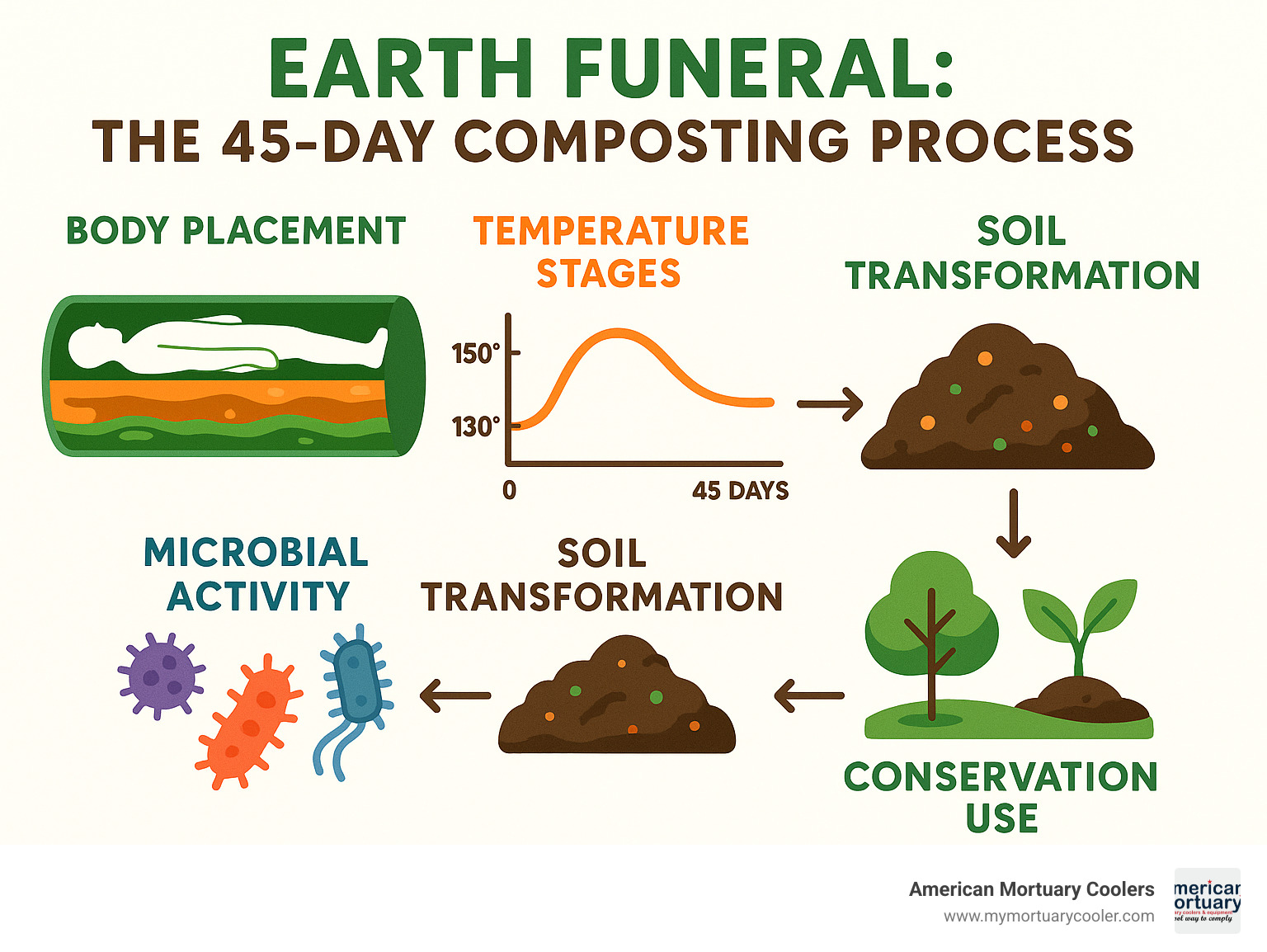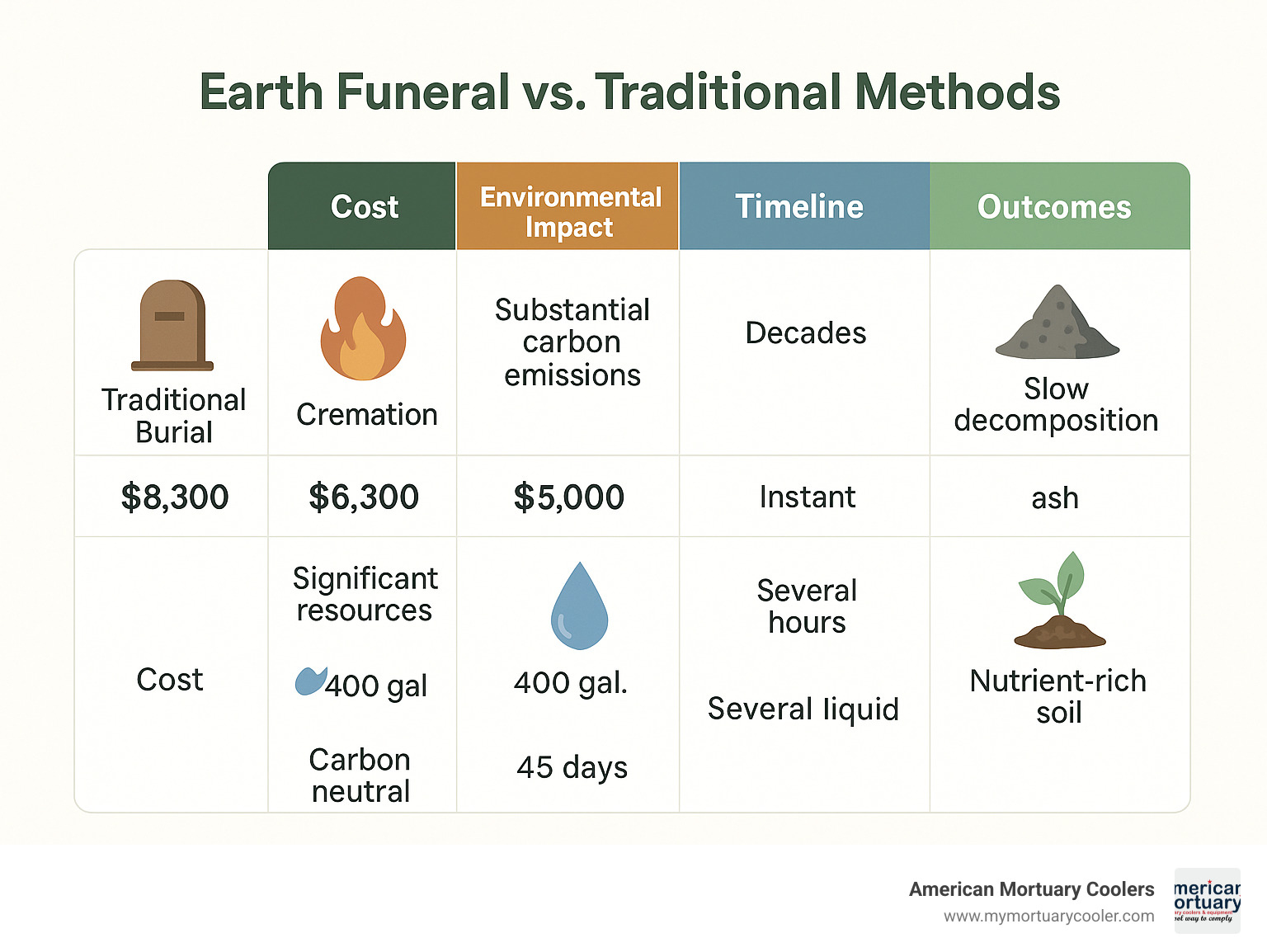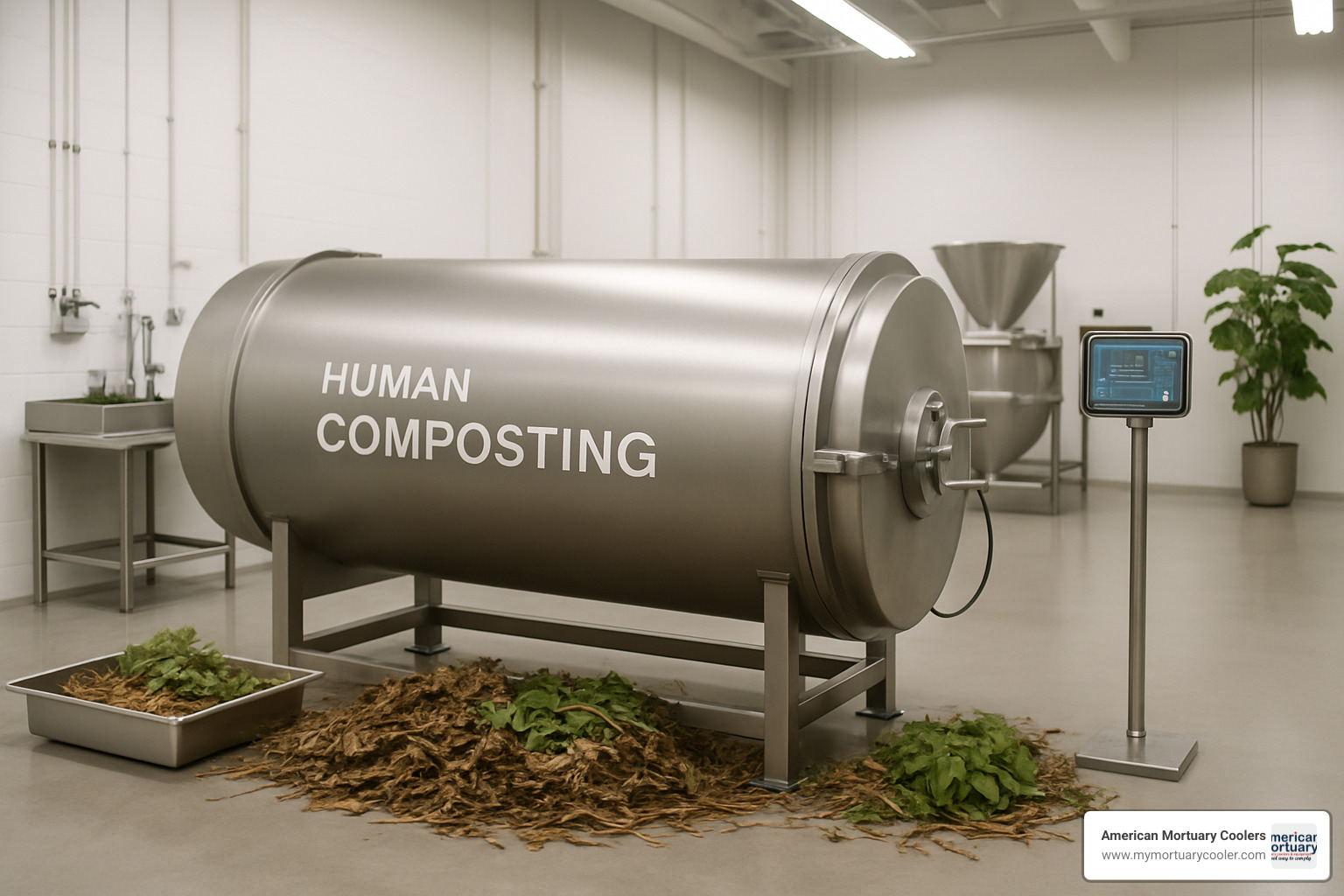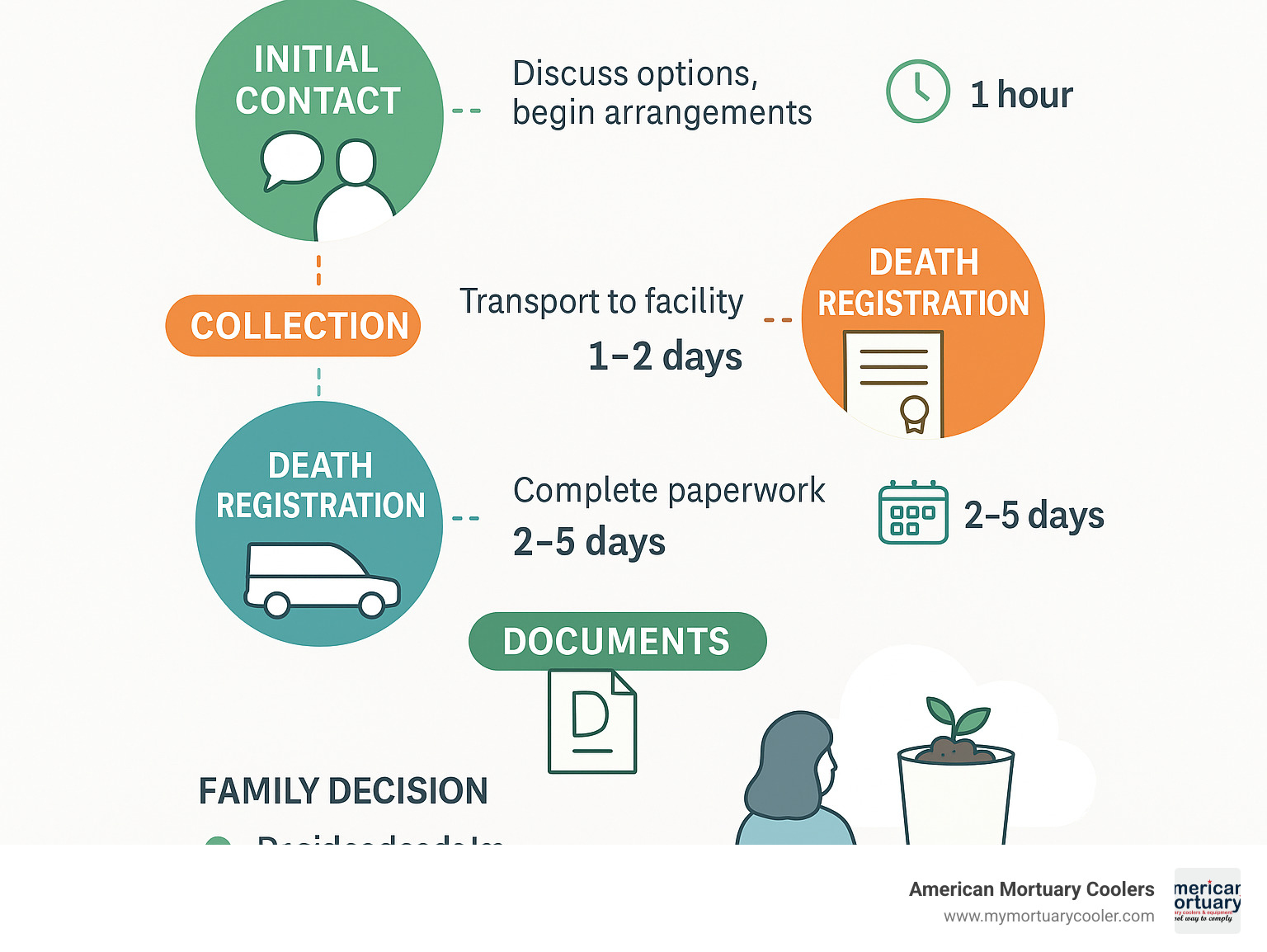Why Earth Funerals Are Changing End-of-Life Care
Earth funeral services are changing how we think about death and returning to nature. Also known as human composting or natural organic reduction, this process gently transforms human remains into nutrient-rich soil over approximately 45 days.
Key Facts About Earth Funerals:
- Process: Bodies are placed in specialized vessels with organic materials
- Timeline: 45-day change period
- Output: Approximately 300 pounds (1 cubic yard) of soil per person
- Cost: Around $5,000, less than traditional burial ($8,300) or cremation ($6,280)
- Legality: Currently legal in 12 U.S. states
- Environmental Impact: Carbon neutral vs. 535 lbs of CO₂ from cremation
The concept isn't entirely new. As one industry expert noted, "In early America, home funerals were the practice everywhere, and each community had a group of women who came in to help with the 'laying out of the dead.'" Today's earth funeral process simply accelerates what happens naturally in soil using controlled conditions and beneficial microorganisms.
Since 2022, companies like Earth Funeral have served over 2,500 families, with 68% of consumers now expressing interest in nontoxic end-of-life alternatives according to the 2024 National Funeral Directors Association survey. This growing demand reflects both environmental consciousness and the desire for meaningful ways to give back to the earth.
I'm Mortuary Cooler, a national-level mortuary equipment supplier with extensive experience helping funeral homes adapt to evolving earth funeral trends and storage needs. My background includes working with funeral directors nationwide to understand the equipment requirements for emerging green burial practices and human composting facilities.

Basic earth funeral glossary:
What Is an Earth Funeral and How It Works
Think of an earth funeral as nature's way of recycling, but with a gentle helping hand from science. Also called human composting, terramation, or natural organic reduction, this process takes what normally happens in forest floors and speeds it up in a controlled, respectful environment.
Here's how it works: instead of fighting natural decomposition with chemicals and metal caskets, earth funerals accept it. The deceased is placed in a special vessel alongside organic materials like wood chips, alfalfa, and straw. It's like creating the perfect compost recipe, but for a much more meaningful purpose.
The real heroes of this process are tiny microorganisms that already exist all around us. These beneficial microbes do what they've always done - break down organic matter - but under carefully controlled conditions. They consume the body's tissues while producing heat, carbon dioxide, and water vapor. The whole process takes about 45 days and results in nutrient-rich soil that can help new life grow.
Earth Funeral Basics – The Natural Process
The earth funeral process starts with treating the deceased with the same dignity as any other funeral method, but without the chemicals. No embalming fluids are used, which means natural decomposition can happen as intended. The body is wrapped in a biodegradable shroud and placed directly into the composting vessel.
What happens next is actually pretty fascinating from a science perspective. The decomposition unfolds in three natural phases that mirror what happens in healthy soil everywhere. First, mesophilic microorganisms start breaking down the easier-to-digest compounds, slowly warming things up. Then thermophilic bacteria take over, creating the high-heat environment that eliminates any harmful pathogens.
Finally, as the active decomposition winds down, the temperature drops and beneficial soil microorganisms move in to finish the job. The vessel gets rotated periodically to ensure everything decomposes evenly and gets proper airflow.
Temperature control is crucial throughout the entire 45-day timeline. The vessel maintains temperatures between 131-160°F during the most active phase. This heat level ensures complete decomposition while creating pathogen-free soil that's safe to handle and use. Oxygen levels are monitored too, keeping conditions aerobic so there are no unpleasant odors.
Earth Funeral vs. Traditional Methods
When you compare earth funerals to burial, cremation, and aquamation, the differences in speed, environmental impact, and meaningful legacy creation become pretty clear. Traditional burial can take decades for complete decomposition, while cremation happens instantly but comes with a hefty environmental cost.
The speed advantage really stands out. A body buried in regular soil might take 8-12 years to fully decompose, depending on conditions. The controlled environment of human composting gets the job done in just 45 days by providing optimal moisture, temperature, and microbial conditions.
But the environmental comparison is where earth funerals really shine. The average cremation produces 535 pounds of CO₂ - that's like driving over 600 miles in terms of carbon emissions. Traditional burial requires significant resources for manufacturing caskets and vaults, plus ongoing cemetery maintenance that continues for decades.
Earth funerals are carbon neutral and actually help sequester carbon in the resulting soil. Instead of adding to environmental problems, this method creates something beneficial that can support new plant growth and forest restoration projects.
Environmental & Cost Advantages of Human Composting
When it comes to caring for our planet, earth funerals offer some pretty impressive benefits that go way beyond just being carbon neutral. Think about it - each human composting process creates roughly 300 pounds of nutrient-rich soil that's packed with beneficial microorganisms and essential nutrients. This isn't just dirt; it's high-quality compost that can breathe new life into reforestation projects, restore damaged ecosystems, and support conservation efforts.
The water savings alone are eye-opening. While aquamation uses around 400 gallons of water, earth funerals need only about 40 gallons for the entire process. That's a 90% reduction in water usage - something that matters more and more as communities face water shortages.
What really sets earth funerals apart environmentally is their use of 100% renewable energy at modern facilities. But here's the kicker: the soil that's created actually sequesters carbon when it's used in conservation projects. So instead of pumping 535 pounds of CO₂ into the atmosphere like cremation does, you're actually helping remove carbon from the air. It's like the difference between adding to the problem and being part of the solution.
From a financial standpoint, earth funerals make end-of-life care more accessible to families. At around $5,000, human composting costs significantly less than traditional burial (which averages $8,300) or even cremation ($6,280). That price tag covers everything you need: licensed funeral director services, body collection, all the paperwork, the complete 45-day change process, soil return in biodegradable containers, and often includes impact tree planting too.

The reforestation impact creates something truly meaningful for families. Companies like Earth Funeral have established dedicated conservation sites where donated soil helps restore native trees like Maple, Cedar, and Douglas-fir. Many earth funeral packages include planting 5 impact trees through partnerships with organizations like One Tree Planted, creating a living memorial that grows stronger each year.
It's hard to find another end-of-life option that combines affordability, environmental benefits, and such a positive lasting impact. For families looking to leave the world a little better than they found it, the numbers speak for themselves.
For more detailed information about carbon emissions research, visit Scientific research on carbon emissions.
Legal, Cultural & Regulatory Landscape
The legal landscape for earth funerals is evolving rapidly across America. Currently, 12 states have acceptd human composting as a legal end-of-life option: Washington, Oregon, California, Nevada, Arizona, Colorado, Minnesota, Vermont, New York, Maine, Maryland, and Delaware. Washington blazed the trail in 2019, becoming the first state to recognize this gentle alternative to traditional burial and cremation.
Each state approaches earth funeral regulation differently, but all maintain rigorous oversight. State licensing requirements ensure facilities meet comprehensive safety standards before opening their doors. These aren't casual operations - they're sophisticated facilities that undergo annual inspections by state health departments and environmental agencies.
The inspection process is thorough and reassuring. Regulators examine everything from temperature monitoring systems to staff training protocols. Every batch of soil undergoes comprehensive lab analysis to verify it's pathogen-free and safe for conservation use. This level of oversight addresses legitimate public health concerns while supporting innovation in end-of-life care.
Cultural acceptance of human composting continues growing, though it varies by community and religious background. Many families find earth funerals align beautifully with their environmental values and desire to leave a positive legacy. As one family member shared about their loved one's choice: "The idea of being gently transformed into soil and returned to nature seemed way more appealing than being cremated at 1,500 degrees."
Religious perspectives on earth funerals remain mixed. The Catholic Church has expressed concerns about human composting, viewing it as potentially incompatible with traditional beliefs about bodily dignity. However, many other faith communities and individuals find the practice deeply meaningful - a way to participate in creation's natural cycles while caring for the environment.
Safety standards for human composting facilities are impressively strict. Operators must maintain precise temperature monitoring throughout the 45-day process, ensuring pathogen elimination while preserving beneficial microorganisms. Proper handling protocols govern every step, from initial preparation through final soil delivery.
The regulatory framework continues strengthening as more states consider legalization. Initial facilities often face extra scrutiny, with extensive lab analysis performed on early cases to build confidence in the process. This careful approach has helped establish human composting as a legitimate, safe alternative that meets rigorous health and safety requirements.
For comprehensive information about body composting laws, visit More info about body composting laws.
Planning and Arranging an Earth Funeral

Planning an earth funeral doesn't have to feel overwhelming, even during such a difficult time. Most families find the process surprisingly straightforward, especially with today's online portals that handle much of the paperwork and coordination. These digital platforms let you complete basic arrangements in about 15 minutes, and there's always someone available to help 24/7 when questions come up.
Many people choose prepaid plans to take the pressure off their families later. These plans lock in today's pricing (which is helpful given inflation) and make sure your wishes are clearly documented and legally binding. When you prepay, everything gets taken care of - the licensed funeral director guidance, body collection and care, death certificate filing, the 45-day soil change process, and even the biodegradable container for returning your soil to family.
The soil return options give families some beautiful choices for honoring their loved ones. You get to decide how much of those 300 pounds of nutrient-rich soil to keep for personal use. Some families scatter it in meaningful places, others create memorial gardens, and many plant trees or flowers as living tributes. Whatever soil you don't use gets donated to conservation projects, helping restore forests and ecosystems.
Transportation logistics can get a bit complex since earth funeral facilities aren't available everywhere yet. If you live in a state where human composting isn't legal, don't worry - local funeral homes can coordinate transport to the nearest facility. This might involve dry ice packing or even air travel, but the providers handle these details so families don't have to stress about logistics during an already difficult time.
Family rituals around earth funerals often become deeply meaningful experiences. Some families visit the facility during the process, hold memorial services at conservation sites, or organize soil scattering ceremonies with extended family and friends. Others create memorial gardens in their backyards or participate in tree planting events at restoration sites. These rituals help families process their grief while creating something positive for the environment.

Understanding the timeline helps families know what to expect. The initial contact usually takes about an hour to discuss options and begin arrangements. Body collection happens within 1-2 days, while death certificate processing takes 2-5 days depending on your state. The soil change process takes exactly 45 days, and soil return happens within 1-3 days after that. From start to finish, the entire process takes about 8 weeks.
At American Mortuary Coolers, we've seen how funeral homes across the country are adapting to serve families interested in these eco-friendly options. The equipment needs are different from traditional services, but the goal remains the same - helping families honor their loved ones with dignity and care.
For detailed information about human composting options, visit More info about human composting options.
Frequently Asked Questions about Earth Funerals
When families first learn about earth funerals, they naturally have questions about this relatively new end-of-life option. Having worked with funeral homes across the country, I've seen these same concerns come up repeatedly. Let me walk you through the most common questions families ask.
The eco-benefits, legality, and practical aspects of soil use are the three main areas people want to understand before making this important decision for themselves or their loved ones.
How long does an earth funeral take?
The earth funeral process takes 45 days to gently transform a human body into rich, fertile soil. This isn't rushed - it's a carefully monitored timeline that ensures complete and safe decomposition.
But here's what most families really want to know: the entire journey from start to finish typically takes about 8 weeks total. This includes time for paperwork, transportation to the facility, and preparing the final soil for return to your family.
The 45-day composting period happens in three natural phases. Days 1-15 begin the initial breakdown, days 16-35 involve the active high-heat phase that eliminates any harmful bacteria, and days 36-45 allow the soil to cure and stabilize. Throughout this time, temperature and moisture are carefully controlled to ensure everything proceeds safely.
Many families find comfort in knowing their loved one's change is being monitored with such care and attention to detail.
What can families do with the resulting soil?
Each earth funeral produces about 300 pounds of nutrient-rich soil - roughly one cubic yard. That might sound like a lot, but families often find meaningful ways to use every bit of it.
You can keep as much or as little as feels right for your family. Some people take just a small portion to scatter in a favorite garden or special place. Others keep enough to plant a memorial tree or create a dedicated garden space. The choice is entirely yours.
What happens to the rest? It goes toward conservation and reforestation projects. Your loved one's soil helps restore damaged ecosystems, supports new tree growth, and literally gives back to the earth. Many families find deep meaning in knowing their person continues nurturing new life.
The soil itself is incredibly rich - full of beneficial microorganisms that help plants thrive. Families often tell us how beautiful their memorial gardens grow, or how the tree they planted with their loved one's soil seems to flourish in ways that feel almost magical.
How much does an earth funeral cost?
An earth funeral typically costs around $5,000, which is significantly less than traditional burial at $8,300 or even cremation at $6,280. For many families, this makes environmental responsibility more accessible.
This price covers everything you need: licensed funeral director services, body collection and care, all the paperwork and death certificates, the full 45-day composting process, biodegradable containers for your soil, and access to online portals where you can get updates throughout the process.
Additional costs might include transportation if you're far from a facility, or special memorial services. But most providers are upfront about pricing - no surprise fees or hidden costs.
Many companies offer prepaid plans that lock in today's prices while documenting your wishes legally. It's one less burden for your family during a difficult time, and it ensures your earth funeral happens exactly as you want it.
The financial accessibility of human composting means more families can choose this environmentally conscious option without breaking the bank.
Conclusion

When you choose an earth funeral, you're creating something beautiful from life's final chapter. Each person becomes approximately one cubic yard of rich, living soil that goes on to nurture forests, restore damaged land, and support new growth for generations to come. It's a legacy that keeps giving back to the earth.
The numbers tell a compelling story about why families are embracing earth funerals. With 68% of consumers now seeking environmentally-friendly alternatives, human composting offers exactly what people want - a way to honor loved ones while protecting the planet. Instead of releasing 535 pounds of CO₂ like cremation does, the process actually helps the environment by creating soil that stores carbon naturally.
We've seen this shift at American Mortuary Coolers. More funeral homes across our service area are asking about equipment for earth funeral preparations. Our custom mortuary coolers help these forward-thinking funeral homes maintain proper storage conditions, ensuring every family receives the dignified care they deserve. Whether a funeral home is in Tennessee or anywhere across the contiguous 48 states, we're here to support this important transition.
The future looks bright for earth funerals as more states recognize their benefits and families find this meaningful option. The combination of environmental stewardship, cost savings, and the chance to create lasting conservation impact makes human composting more than just an alternative - it's a way to turn grief into hope and loss into lasting legacy.
Your loved one's soil might help restore a forest, support a memorial garden, or bring new life to damaged land. That's the kind of legacy that makes a difference long after we're gone.
For additional information about natural organic reduction trends, visit More info about prepaid guides.


















